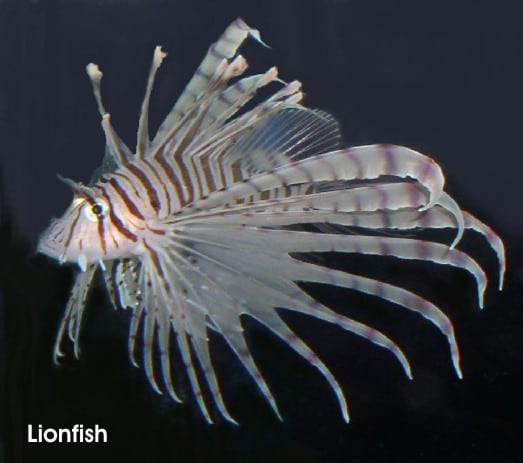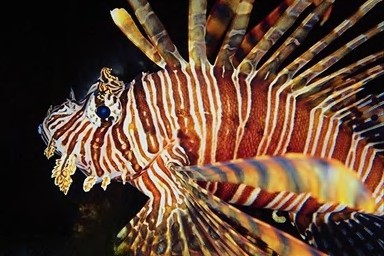I honestly believe that one of the fish that will bring the most attention to a saltwater tank is the Lionfish. Lionfish are related to the scorpion and deadly stonefishes. Almost all of these species are poisonous and should always be handled with care and protection to yourself. Many tank owners acquire these beautiful and intriguing fish as centerpieces to their aquariums.


One of the most common lionfish in the trade is the volitans (Pterois volitans). P. volitans goes by the common names of turkeyfish, red firefish, common lionfish, peacock lionfish, scorpion volitans and butterfly cod. One of the main reasons that it has so many names, is because it is found widely throughout the Indo-Pacific and Africa. For the genus Pterois, authorities prefer the name turkeyfish over lionfish, but I still prefer to call them lionfish. The volitans is now also found in the coastal waters along the Eastern United States, from Florida to New York. Their release may have been deliberate and/or accidental via large commercial ships crossing the ocean. It is unclear what impact this non-indigenous lionfish will have on the ecosystem there.
The volitans lionfish, can be identified by it’s red and white vertical stripes along the body; large fan-like pectoral fins sparse with flesh, and tall banded spines on the dorsal fin.


Pterois volitans
In the trade, the volitans might mistakenly be listed as ragged-finned firefish or Pterois antennata (or vice versa). These species can be distinguished by the shape and color of the pectoral fins. The fins of P. volitans are more pointed and covered with variable spots and bands, with 16-17 pectoral rays, while P. antennata has more rounded fins which are white to gold in color, with 14-16 pectoral rays.
Lastley, you will also want to keep an eye out for the less common P. sphex (meaning wasp) called the Hawaiian lionfish (endemic to Hawaii). Again, this lionfish is similar in appearance, but has predominantly white pectoral spines. My suggestion is to research pictures of all the lionfish and familiarize yourself with the subtle differences between them before purchasing one.
Part of the captivating mystique of lionfish is also that, which you should look out for! The large fins, which are made of spines without flesh, are poisonous. Often, instead of swimming away from divers, or intruders into the tank, they will simply point the fins towards that intruder as a warning. I have been told that a sting from a volitans feels somewhere between being slightly more painful than a bee sting to feeling like one is being repeatedly smashed in the fingers with a hammer! Fortunately, I have not experienced one yet (knock on wood ). A volitans’ sting will produce pain, redness and swelling. With exposure to a lot of venom, one may also have nausea, vomiting, weakness, shortness of breath, delirium and abdominal pain. If you were to be unfortunate enough to get stung by your pride and joy, you should apply heat for 30-90 minutes because this helps to break apart the proteins in the venom. Later, ice and a treatment of corticosteroids can be applied topically. It is suggested to seek professional help and this is mandatory if you have any severe symptoms. The aquarist most often gets stung when cleaning the tank or transferring their lionfish, so be very cautious during these times. You can also protect your upper extremities by wearing long Platex-like gloving.
In the wild, the fins and stingers are used for both protection and hunting food. In the tank, the volitans will still hunt by flaring its’ fins to herd prey into a corner, then sting the prey before consuming it. In the wild, lionfish may be found in habitats ranging from lagoons to reefs up to 50 meters in depth. During the day, a volitans may hide in your rockwork as they do in the wild, but may be coaxed out with live/meaty foods. The volitans can often be observed hunting for food after the lights go out.
Lionfish are carnivores, and they should be kept on a meaty diet with occasional live fish or crustacean flesh as treats. For feeder fish, you can use damsels, or comet goldfish or guppies, which can be acclimated so that they sustain life for a short period of time in the saltwater environment. Always be sure that feeder fish are disease free before letting your lionfish consume them. Also, raw goldfish flesh contains thiaminase, an enzyme that causes the breakdown of thiamine. If your lionfish is fed a diet that consists only of goldfish, then it may become thiamine deficient, which can result in health problems, particularily of the nervous system.Your volitans can be fed snails, small hermit crabs and gut-loaded ghost shrimp but since crustaceans can become expensive quickly, it is more reasonable to acclimate your lionfish to cocktail shrimp. Your lionfish should only be fed 2-3 times per week and the diet should be varied to avoid health problems.
Some keepers say that these lionfish are reef compatible, but I strongly recommend that this be done only with caution. I have heard several stories of lionfish that had never harmed a decorative invertebrate for years only to turn around and devour every one in a few nights span. I would suggest adding your prize lionfish last to the tank, as this will give some time for potential morsels to establish safe homes, where they can hide from a lion on the prowl. A volitans will try to consume any small fish or crustacean that it can fit into its’ mouth, so beware of how large your fish can potentially become when selecting tankmates. The volitans has been known to top 15 inches in captivity. The lionfish tends to be peaceful towards fish of its’ own size or larger, but is known to strike when provoked. Good tankmates are tangs, sturgeon fish and boxfish. You can also house them with triggers, however, you must be careful because as triggers get older, they can become aggressive to their tankmates.
If you are considering a volitans, it is suggested to have a minimum of a 50 gallon tank (190 liters). Even though some volitans may not be very active swimmers, there should be enough room for it to roam without fear of its’ spines getting entangled with rock, decorations, or equipment. The volitans prefers a temperature of 77-79°F (25-26°C), sg 1.021-1.023, pH 8.1-8.4, and dKH 8-12. Out of all the lionfish, the volitans is considered to be the easiest to care for, so this is a good fish for the saltwater beginner. All fish should undergo at least two weeks of quarantine, before being placed into your display tank, yet I usually suggest more time, such as three to four weeks, so that you are confident that your new lionfish is of good health. P. volitans is not listed as threatened by the International Union for Conservation of Nature and Natural Resources (IUCN).
On a side note, in Hawaii, the P. sphex (endemic to Hawaii) is called the nohu pinao, after the dragonfly. If you have ever watched a lionfish sail over a reef searching for food, this is a very apt description. The name nohu, is carried over to other scorpion fish found in Hawaii, and nohu is also used in the south pacific to descibe the deadly stonefish. In Hawaii, myth has it that eggs of some nohu will hatch into sharks!